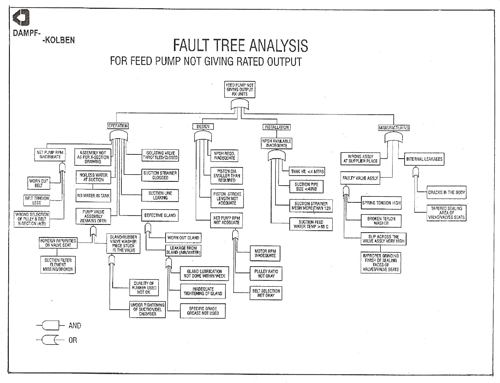Trouble Shooting
4.1 Variation in flow
Follow the below given guidelines in their order.
- Check suction strainer. Clean/replace to ensure free flow. Check suction/delivery pipe sizes. (Recommended pipe ID should be equal to or greater than the respective nozzle size)
- Check pump speed by putting the tachometer at the pump shaft. The pump flow is directly proportional to the pump speed. Hence, a flow at a particular speed can be calculated by using simple law of proportionality. Verify whether the calculated flow is in line with the required flow. (In case the pump speed is 475 rpm the pump capacity shall be 1080 Lts / hr. in case of a triplex pump)
- Check grease nipple/s for adequate grease quantity. Check if the grease is dry. Replenish with fresh and adequate grease. Tighten grease nipples by 2 to 3 rotations and visually ensure a light film of grease on the reciprocating piston/s. (Dried/inadequate grease sometimes even results in zero flow.)
- Loosen gland nuts. Remove hydraulic assembly by unscrewing the coupling union nuts. (Do not touch the vertical tie bolts) Remove gland nut, oil ring, gland washers and packing retainer/throat bush. Check gland washers and throat bush for wear and tear/twist. Repeat this procedure in case of duplex and triplex pumps. Replace worn out parts. Ensure proper gland nut tightening.
- Loosen the tie bolts. Remove all the valve seat assemblies and sealing washers one by one. Check individual valve seat assembly. Wipe and clean the complete assembly. Check the sealing surface for scratches/wear and tear. Replace, if necessary. Please note that the PTFE washers act as pressure sealing gaskets, and hence must be replaced once suction, delivery chambers are dismantled. Ensure all fitment are in order.
4.2 Undue Noise
- Check pump/pump platform for proper mounting.
- Check pulleys for run out and proper fitment on the shafts. Check belt tension.
- Check crankcase oil level.
- Check connecting rod bolts for proper tightening, in case removed or replaced.
- Check con-rod bearings for wear and tear. Replace, if necessary.
- Check con-rods for bends. Replace, if necessary.
- Check ball bearings. Replace, if necessary.
- Check whether pump speed exceeds maximum allowable limit.
4.3 Undue vibration
- Check whether pump speed exceeds maximum allowable limit.
- Check pump / pump platform for proper mounting.
- Check suction strainer/suction piping. If chocked, clean/replace to ensure free flow.
- Check delivery piping. Clean if chocked.
- Check pulleys for run out and proper fitment on the shafts.
- Check belt tension.
- Check connecting rod bolts for proper tightening, in case removed or replaced.
- Ensure proper size / location of big end con-rod bearings, in case removed or replaced.
4.4 Line pulsations/pressure variations
- Check belt tension.
- Check suction and delivery lines, filters and other accessories for clogging.
- Check connecting rod bolts for proper tightening, in case removed or replaced.
- Ensure proper size / location of big end con-rod bearings, in case removed or replaced.
- Check ball bearings.
- Check and verify the quality/locations of stuffing box internals.
4.5 Pump Leakages
- Check Teflon washers for distortion, in case leakage is observed from sealing ports (i.e. joints in between suction chamber and valve box, delivery chamber and valve box) Replace, if distorted. Tighten tie bolts evenly to ensure leak proof joints.
- Tighten gland nut/s in case of leakages from the valve box. Check gland washers for wear and tear. Replace, if necessary.
- Check piston oil seals / bearing oil seals in case of oil leakages. Replace, if necessary. Check vent holes of breather and clean if necessary as the pressure of the accumulated hot air inside the crank case can lead to oil seal failures.
- Adopt proper oil filling procedure (refer Lubrication) in case of leakages from the bottom side of reservoir cup. Please note that the stem of the CLO never gets totally filled up and hence the question of oil leakage from the top of the stem / V-notch will never arise.
4.6 Piston Scoring
- Avoid over tightening of gland nuts. Check whether gland washers are hardened because of lack of proper lubrication.
- Check grease quality. Check free flow of grease from grease nipple to the oil ring.
- Check oil ring and packing retainer/throat bush for distortion. Replace, if necessary.
4.7 Bearing failure
- Check and ensure proper quality and quantity of lube oil. Check lube oil temperature.(Refer Lubrication)
- Check and ensure proper alignment of pulleys and belt tension.
- Check proper fitment of bearings, if removed or replaced. (Refer Repairs)
- Check size and fitment of con rod big end bearings, in case replaced. (Refer Repairs)
4.8 Pump runs hot
- Check temperature of the liquid handled.
- Check fitment and quality of con rod big end as well as ball bearings, in case replaced.
- Check con rod bolts for excessive tightening, in case replaced.(Refer Repairs)
- There is every possibility that the pump may run hot during the first 80 to 100 hours of operation. This is on account of the heat generated due to the constant rubbing of mechanical parts. The heat generation reduces as these parts gain mating tolerances








